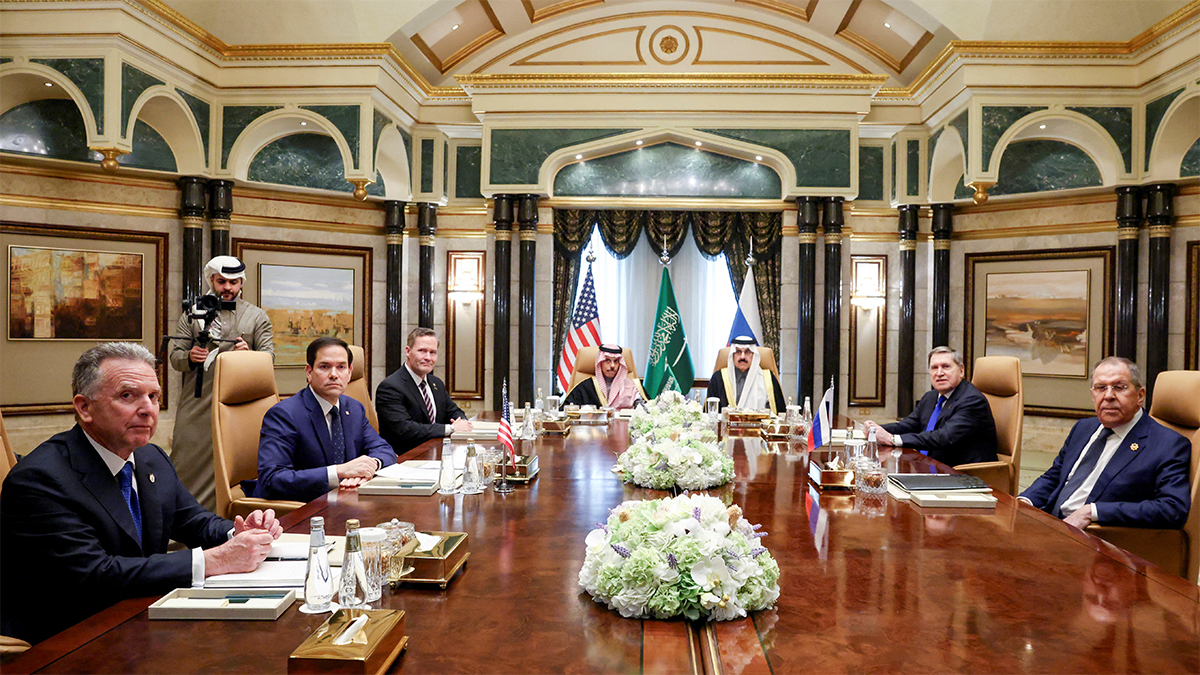The US-Russia talks in Saudi Arabia on Tuesday marked a profound shift in Washington’s stance toward Moscow igniting fears about Ukraine’s fate and Europe’s strategic position. With Trump spearheading a new engagement, the prospect of a deal to end the war looms large—but at what price?
What the envoys of US President Donald Trump and Russia’s Vladimir Putin did in Riyadh was actually to preview the talks to decide the future of Ukraine, ironically, without the Kyiv or its European Union allies having a say in it.
Here’s a breakdown of the key implications of the talks:
1. US and Russia to name negotiators to chart out Ukraine’s future – without Ukraine
• For the first time since the early days of the war, the US and Russia have agreed to set up a high-level team of negotiators to discuss Ukraine’s future. However, Kyiv was notably absent from the talks, fuelling concerns that Ukraine is being sidelined in a deal that will shape its own territorial integrity and security.
• Marco Rubio and Sergei Lavrov, the key figures in Riyadh, hinted at a long negotiation process, but no clear terms emerged. Trump’s remark—“You should have ended it three years ago”—suggests a push to force Ukraine into an unfavourable peace deal rather than secure a just resolution.
2. A major US policy shift: Ending Putin’s global isolation
• The Riyadh talks mark a dramatic departure from the Biden administration’s policy of isolating Russia through economic sanctions and military aid to Ukraine. Under Trump’s direction, Washington engaged directly with Putin’s closest advisers, signalling a willingness to rehabilitate Russia’s position on the global stage.
Impact Shorts
More Shorts• The US delegation, led by Secretary of State Marco Rubio, took a conciliatory approach, discussing economic cooperation and diplomatic normalisation—moves that were unthinkable under Biden. This shift raises questions about whether sanctions could be lifted in exchange for a settlement that benefits Moscow.
3. Ukraine and Europe left out: The growing isolation of allies
• The absence of Ukraine and European nations from the Riyadh discussions was met with alarm in Kyiv and Brussels. Zelenskyy flatly rejected any outcome negotiated behind Ukraine’s back, stating: “No decision can be made without Kyiv.”
• European leaders scrambled to reassert their relevance with EU foreign policy chief Kaja Kallas warning against divisions, while French President Emmanuel Macron called for strong security guarantees for Ukraine. The talks also exposed cracks within Europe as leaders struggled to agree on a unified response—particularly over sending peacekeeping troops to Ukraine.
The big question remains: Is Trump deserting Europe to forge his own deal with Russia?
4. A new Trump-Putin axis? The three key priorities
Rubio laid out three main objectives from the US side:
• Restoring embassy staffing in Washington and Moscow – a step toward normalising relations
• Exploring economic opportunities - hinting at a possible US return to Russian markets, particularly in energy.
• Creating dedicated teams for peace talks – setting the stage for a Trump-Putin diplomatic channel outside of traditional alliances.
Meanwhile, Russia’s demands remain as aggressive as ever—an end to Nato expansion, a rollback of Western military deployments and the formal abandonment of Ukraine’s Nato aspirations. The question is: Will the US entertain these demands in pursuit of “peace” with Russia?
5. Europe scrambles as confusion and divisions grow
The Riyadh talks have thrown Europe into turmoil with no clear strategy on how to react. While Macron attempted diplomatic damage control by reaching out to Trump and Zelenskyy, European leaders struggled to coordinate a firm stance.
The biggest dilemma? Should Europe support a US-Russia peace deal, or push back and risk being further sidelined? Nato remains wary and any concessions to Russia could undermine the alliance’s credibility—especially in Eastern Europe where fears of Russian expansion persist.
With the US now leading peace talks independently, the stakes for Europe have never been higher. Will they stand firm or be forced to accept a settlement on Trump’s terms? The answer to this question has the potential to decide the future of geopolitics for years to come.


)

)
)
)
)
)
)
)
)



